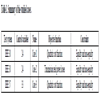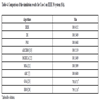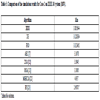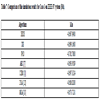- Home
- About Journals
-
Information for Authors/ReviewersEditorial Policies
Publication Fee
Publication Cycle - Process Flowchart
Online Manuscript Submission and Tracking System
Publishing Ethics and Rectitude
Authorship
Author Benefits
Reviewer Guidelines
Guest Editor Guidelines
Peer Review Workflow
Quick Track Option
Copyediting Services
Bentham Open Membership
Bentham Open Advisory Board
Archiving Policies
Fabricating and Stating False Information
Post Publication Discussions and Corrections
Editorial Management
Advertise With Us
Funding Agencies
Rate List
Kudos
General FAQs
Special Fee Waivers and Discounts
- Contact
- Help
- About Us
- Search

The Open Electrical & Electronic Engineering Journal
(Discontinued)
ISSN: 1874-1290 ― Volume 13, 2019
Optimal Power Flow Using an Improved Hybrid Differential Evolution Algorithm
Gonggui Chen1, 2, *, Zhengmei Lu1, 2, Zhizhong Zhang3, Zhi Sun4
Abstract
Objective:
In this paper, an improved hybrid differential evolution (IHDE) algorithm based on differential evolution (DE) algorithm and particle swarm optimization (PSO) has been proposed to solve the optimal power flow (OPF) problem of power system which is a multi-constrained, large-scale and nonlinear optimization problem.
Method:
In IHDE algorithm, the DE is employed as the main optimizer; and the three factors of PSO, which are inertia, cognition, and society, are used to improve the mutation of DE. Then the learning mechanism and the adaptive control of the parameters are added to the crossover, and the greedy selection considering the value of penalty function is proposed. Furthermore, the replacement mechanism is added to the IHDE for reducing the probability of falling into the local optimum. The performance of this method is tested on the IEEE30-bus and IEEE57-bus systems, and the generator quadratic cost and the transmission real power losses are considered as objective functions.
Results:
The simulation results demonstrate that IHDE algorithm can solve the OPF problem successfully and obtain the better solution compared with other methods reported in the recent literatures.
Article Information
Identifiers and Pagination:
Year: 2017Volume: 11
First Page: 177
Last Page: 192
Publisher Id: TOEEJ-11-177
DOI: 10.2174/1874129001711010177
Article History:
Received Date: 09/08/2017Revision Received Date: 18/08/2017
Acceptance Date: 20/08/2017
Electronic publication date: 31/10/2017
Collection year: 2017
open-access license: This is an open access article distributed under the terms of the Creative Commons Attribution 4.0 International Public License (CC-BY 4.0), a copy of which is available at: https://creativecommons.org/licenses/by/4.0/legalcode. This license permits unrestricted use, distribution, and reproduction in any medium, provided the original author and source are credited.
* Address correspondence to this author at the Research Center on Complex Power System Analysis and Control, Chongqing University of Posts and Telecommunications, Chongqing 400065, P.R. China; Tel: +86-15696106539; Fax: +86-23-62461535; E-mails: chenggpower@163.com, chenggpower@126.com
| Open Peer Review Details | |||
|---|---|---|---|
| Manuscript submitted on 09-08-2017 |
Original Manuscript | Optimal Power Flow Using an Improved Hybrid Differential Evolution Algorithm | |
1. INTRODUCTION
Due to the development and extension of the traditional economic scheduling theory, the optimal power flow (OPF) problem considering the economy and security of the power system has drawn a lot of attention, which is a multi-constrained, non-linear and non-convex optimization problem containing continuous and discrete control variables. Since the OPF formulation by Carpentier in 1962, its usefulness is progressively being recognized, and nowadays it becomes the most important tool used in operation and planning of power system [1H.R. Bouchekara, A.E. Chaib, M.A. Abido, and R.A. El-Sehiemy, "Optimal power flow using an Improved Colliding Bodies Optimizationalgorithm", Appl. Soft Comput., vol. 42, pp. 119-131.
[http://dx.doi.org/10.1016/j.asoc.2016.01.041] ]. The OPF problem is aimed to give the optimal settings of determined control variables for optimizing a specific objective function, such as the generation cost function, transmission real power losses and voltage deviation, while satisfying some equality and inequality constraints. It can respect the system static security constraints and schedule active and reactive power [2S.S. Reddy, and P.R. Bijwe, "Efficiency improvements in meta-heuristic algorithms to solve the optimal power flow problem", Elect. Power Energy Sys., vol. 82, pp. 288-302.
[http://dx.doi.org/10.1016/j.ijepes.2016.03.028] ].
Nowadays, many optimization methods are employed successfully to solve the OPF problem and can be divided into two categories: the traditional mathematical methods and the intelligent optimization methods. The traditional mathematical methods include linear programming method [3B. Mota-Palomino, and V.H. Quintana, "Sparse Reactive Power Scheduling by a Penalty Function - Linear Programming Technique", Ieee T Power Syst, vol. 1, pp. 31-39.
[http://dx.doi.org/10.1109/TPWRS.1986.4334951] ], nonlinear programming method [4R. Shoults, and D. Sun, "Optimal Power Flow Based Upon P-Q Decomposition", IEEE Trans. Power Apparatus Syst, vol. PAS-101, pp. 397-405.
[http://dx.doi.org/10.1109/TPAS.1982.317120] ], and simplified gradient method [5J. Carpentier, "Contribution a l’Etude du Dispatching Economique", Bulletin de la Societe Francaise des Electriciens, vol. 3, pp. 431-474.] and so on. Usually, these methods have fast calculation speed and good convergence characteristics, but some restrictions on the variables and the objective functions. Compared with the traditional mathematical methods, the intelligent optimization methods based on the combination of computer technology and biological simulation can be a better way when solving the large-scale, multi-constrained, non-linear and non-convex OPF problem which contains the discrete and continuous variables. Some of the proposed intelligent methods, such as Particle Swarm Optimization with an Aging Leader and Challengers (ALC-PSO) algorithm [6R.P. Singh, V. Mukherjee, and S.P. Ghoshal, "Particle swarm optimization with an aging leader and challengers algorithm for the solution of optimal power flow problem", Appl. Soft Comput., vol. 40, pp. 161-177.
[http://dx.doi.org/10.1016/j.asoc.2015.11.027] ], Artificial Bee Colony (ABC) [7M.R. Adaryani, and A. Karami, "Artificial bee colony algorithm for solving multi-objective optimal power flow problem", Elect. Power Energy Sys., vol. 53, pp. 219-230.
[http://dx.doi.org/10.1016/j.ijepes.2013.04.021] ], Lévy Mutation Teaching–Learning-Based Optimization (LTLBO) algorithm [8M. Ghasemi, S. Ghavidel, M. Gitizadeh, and E. Akbari, "An improved teaching–learning-based optimization algorithm using Lévy mutation strategy for non-smooth optimal power flow", Elect. Power Energy Sys., vol. 65, pp. 375-384.
[http://dx.doi.org/10.1016/j.ijepes.2014.10.027] ], Krill Herd (KH) algorithm [9P. Roy, and C. Paul, "Optimal power flow using krill herd algorithm", Inte. Transac. Elect. Energy Sys., vol. 25, pp. 1397-1419.
[http://dx.doi.org/10.1002/etep.1888] ], Adaptive Real Coded Biogeography-based Optimization (ARCBBO) [10A.R. Kumar, and L. Premalatha, "Optimal power flow for a deregulated power system using adaptive real coded biogeography-based optimization", Elect. Power Energy Sys., vol. 73, pp. 393-399.
[http://dx.doi.org/10.1016/j.ijepes.2015.05.011] ], Moth Swarm algorithm (MSA) [11A.A. Mohamed, Y.S. Mohamed, and A.A. El-Gaafary, "Optimal power flow using moth swarm algorithm", Electr. Power Syst. Res., vol. 142, pp. 190-206.
[http://dx.doi.org/10.1016/j.epsr.2016.09.025] ] and Differential Search algorithm (DSA) [12K. Abaci, and V. Yamacli, "Differential search algorithm for solving multi-objective optimal power flow problem", Elect. Power Energy Sys., vol. 79, pp. 1-10.
[http://dx.doi.org/10.1016/j.ijepes.2015.12.021] ], have been proved to be successful in solving the OPF problem. Therefore,there is an increasing number of studies about the improvement and combination of algorithms or mechanisms.
As a relatively new member of evolutionary algorithms (EAs), DE is also a stochastic model which simulates the biological evolution and has been widely applied to the optimization problems in the power system. The DE consists of four operators: initialization, mutation, crossover and selection, and its performance mainly affected by the strategy of the mutation and control parameters, such as the mutant scale factor F and the crossover factor CR. In the evolutionary process, the difference among individuals will gradually decreases due to the influence of the greedy selection, which affects the diversity caused by the mutation and leads the algorithm to fall into the local optimum. So far, many modified DE algorithms have been proposed to overcome the shortcomings. The authors in [13M. Basu, "Improved differential evolution for economic dispatch", Elect. Power Energy Sys., vol. 63, pp. 855-861.
[http://dx.doi.org/10.1016/j.ijepes.2014.07.003] ] proposed Gaussian random variable instead of scaling factor and the proposed approach was able to provide better solution compared with other evolutionary method for economic dispatch. In [14R.P. Parouha, and K.N. Das, "A memory based differential evolution algorithm for unconstrained optimization", Appl. Soft Comput., vol. 38, pp. 501-517.
[http://dx.doi.org/10.1016/j.asoc.2015.10.022] ], the proposed MBDE method which used memory mechanism to modify mutation and crossover operators provided better results. Obviously, parameter modification, the strategies of mutation and crossover affect the performance of the algorithm to a certain extent. Considering all of the above factors to aptly modify DE algorithm will be a new direction in the further.
Numerous studies indicate that a variety of intelligent algorithms show different strength and weakness in solving some problems and the combination of two or more algorithms can solve the problem more efficiently [15G. Chen, S. Huang, and Z. Sun, "A Chaotic Quantum Behaved Particle Swarm Optimization Algorithm for Short-term Hydrothermal Scheduling", Open Elect. Electro. Engi. J., vol. 11, pp. 23-37.
[http://dx.doi.org/10.2174/1874129001711010023] -17X. Wang, C. Wang, and Q. Li, "Short-term Wind Power Prediction Using GA-ELM", Open Elect. Electro. Engi. J., vol. 11, pp. 48-56.
[http://dx.doi.org/10.2174/1874129001711010048] ]. Hence, a combination of advantages of some algorithms is considered in this paper. Particle swarm optimization (PSO) with inherent parallel search mechanism is especially suitable for complex optimization fields where traditional methods are difficult to work [15G. Chen, S. Huang, and Z. Sun, "A Chaotic Quantum Behaved Particle Swarm Optimization Algorithm for Short-term Hydrothermal Scheduling", Open Elect. Electro. Engi. J., vol. 11, pp. 23-37.
[http://dx.doi.org/10.2174/1874129001711010023] ]. And it can be used to improve the search ability of DE. Thus, the novel hybrid differential evolution (IHDE) algorithm based on DE and PSO is proposed in this paper. Furthermore, what is greatly significant is not only to improve the current methods but also to handle constraints on state variables well simultaneously [18G. Chen, L. Liu, Z. Zhang, and S. Huang, "Optimal reactive power dispatch by improved GSA-based algorithm with the novel strategies to handle constraints", Appl. Soft Comput., vol. 50, pp. 58-70.
[http://dx.doi.org/10.1016/j.asoc.2016.11.008] ]. Briefly, the contributions of this paper can be summarized as follows:
(1) An improved hybrid differential evolution algorithm considering the mutation and crossover strategies and parameter values is proposed, namely IHDE. The mutation and crossover strategies of DE are modified by the memory mechanism of PSO and learning mechanism, respectively. Moreover, the values of the mutant scale factor F, the inertia weight ω and crossover factor CRi are varied according to evolutionary process. Finally, the replacement mechanism is designed for reducing the probability of falling into the local optimum.
(2) A novel constraint handing method including greedy selection strategy and penalty function is proposed to keep the variable within its limits, especially in larger systems.
(3) The OPF problem is implemented on standard IEEE30-bus and IEEE57-bus systems successfully using IHDE algorithm
In the proposed algorithm, the DE is employed as the main optimizer and the three factors of PSO which are inertia, cognition, and society are used to improve the mutation for speeding up the convergence rate. Then the learning mechanism and the adaptive control of the parameters are added to the crossover to increase the diversity of population in some direction. To ensure the optimal solution satisfies the security constraints, the greedy selection mechanism considering the value of penalty function is proposed. Furthermore, the replacement mechanism is added to the IHDE for reducing the probability of falling into the local optimum. Finally, the IHDE, DE and PSO are tested on the IEEE30-bus and IEEE57-bus systems, and the generator quadratic cost and the transmission real power losses are considered as objective functions. The simulation results demonstrate that IHDE algorithm can solve the OPF problem successfully and obtain better solutions compared with DE, PSO and other methods reported in the recent literatures.
The rest of the paper is organized as follows: Section 2 describes the mathematical formulation of the OPF problem. Section 3 introduces the DE and PSO briefly. Section 4 proposes an improved hybrid differential evolution (IHDE) algorithm. Section 5 presents the simulation results and analysis. Finally, the conclusion is drawn in section 6.
2. PROBLEM FORMULATION
As previously mentioned, the objective of the OPF problem is to optimize a specific objective function by finding the optimal settings of determined control variables while satisfying a range of equality and inequality constraints. The model of OPF problem contains five parts: control variable, state variable, objective function, equality constraint, and inequality constraint.
The OPF problem can be mathematically formulated as follows:
 |
(1) |
Subject to
 |
(2) |
Where x and u are the vector of state variables and the vector of control variables, respectively. F(x, u) is the objective function to be minimized. g(x, u) is the set of equality constraints. h(x, u) is the set of inequality constraints.
2.1. Control Variable
The control variables of this model are active power generation PG at PV buses except the slack bus, voltage magnitude VG at PV buses, transformer taps settings T and shunt VAR compensation QC. The control variables can be expressed as:
 |
(3) |
Where NG, NT and NC represent the number of generator buses, the number of regulating transformers and the number of shunt compensators, respectively.
2.2. State Variable
The state variables of this model are active power generation PG1 at the slack bus, voltage magnitude VL at PQ buses, reactive power output QG at PV buses and transmission line loadings (or line flow) Sl. The state variables can be described as follows:
 |
(4) |
Where NL is the number of load buses and NTL is the number of transmission lines; PG1 as the state variable is the active power generation at the slack bus.
2.3. Equality Constraint
The power balance constraints are considered as basic equality constraints and reflect the physics of the power system which can be represented as follows:
 |
(5) |
Where δij=δi-δj.δi and δj are voltage angles at bus i and j, respectively. Ni is the number of buses which are adjacent to bus i, including bus i. NPQ is the number of PQ buses and NS is the number of system buses excluding slack bus. QGi and PGi represent the reactive power output and the active power generation at bus i which belongs PV buses, respectively. QLi and PLi represent the reactive load demand and active load demand at bus i, respectively. Gij and Bij are the conductance and susceptance between bus i and bus j, respectively. Vi is the voltage magnitude at bus i.
2.4. Inequality Constraint
The operating limits of power system are considered as inequality constraints which guarantee the system security.
(a) Generator constraints
 |
(6) |
 |
(7) |
 |
(8) |
(b) Transformer constraints
 |
(9) |
(c) Shunt VAR compensator constraints
 |
(10) |
(d) Security constraints
 |
(11) |
 |
(12) |
2.5. Objective Function
In this paper, two objective functions are considered to evaluate the effectiveness of the proposed algorithm.
2.5.1. Quadratic Cost Function
The objective of the total fuel cost is widely used and it can be formulated by a quadratic curve as follows:
 |
(13) |
 |
(14) |
Where ai, bi and ci are the cost coefficients of the ith generator.
2.5.2. Transmission Real Power Losses
The function determined by the bus voltage magnitude and angle is the total active power loss of all transmission lines and can be calculated as:
 |
(15) |
Where Gk is the conductance between bus i and bus j.
3. BRIEF ON DE&PSO
3.1. Difference Evolution (DE) Algorithm
In DE, the forward direction is based on the differences among all the individuals in the population and the diversity is increased by crossover. Then the greedy selection is used to realize the population evolution. The process of DE includes four steps: initialization, mutation, crossover and selection.
3.1.1. Initialization
The initial population of NP is randomly selected by uniform probability in the search space of the optimization problem. Random values are assigned to each D-dimensional individual according to:
 |
(16) |
Where xj,min and xj,max represent the lower and upper bounds of the jth decision variable; g and NP represent the number of the iteration and population size, respectively.
3.1.2. Mutation
The operator is utilized to generate the mutant vector x′i,g+1 by changing the value of the individual through the difference of other individuals. Recently, there are many mutation schemes of DE in the literature [19G. Li, Q. Lin, L. Cui, Z. Du, Z. Liang, and J. Chen, "A novel hybrid differential evolution algorithm with modified CoDE and JADE", Appl. Soft Comput., vol. 47, pp. 577-599.
[http://dx.doi.org/10.1016/j.asoc.2016.06.011] ] and the strategy commonly used is expressed as follows:
 |
(17) |
Where xr1,g, xr2,g and xr3,g (r1≠r2≠r3≠i) are randomly chosen from the current population; F [0, 2] is the mutant scale factor.
[0, 2] is the mutant scale factor.
3.1.3. Crossover
The operator is utilized to generate a new trial vector x′′i,g+1 and there are two crossover strategies which include the binomial crossover and the exponential crossover [20Z. Zhao, J. Yang, Z. Hu, and H. Che, "A differential evolution algorithm with self-adaptive strategy and control parameters based on symmetric Latin hypercube design for unconstrained optimization problems", Eur. J. Oper. Res., vol. 250, pp. 30-45.
[http://dx.doi.org/10.1016/j.ejor.2015.10.043] ]. In this paper, the binomial crossover is selected for the research and defined as follows:
 |
(18) |
Where CR [0,1] is the crossover factor; m
[0,1] is the crossover factor; m [1,D] is a random integer which ensures x′′i,g+1 can get at least one parameter from x′i,g+1.
[1,D] is a random integer which ensures x′′i,g+1 can get at least one parameter from x′i,g+1.
3.1.4. Selection
The operator is utilized to choose a better vector between the trial vector x′′i,g+1 and the target vector xi based on fitness values. f (x) is the fitness function value of x. Therefore the selection criterion is expressed as follows:
 |
(19) |
3.2. Particle Swarm Optimization (PSO)
In PSO, each particle represents a potential solution for the specific issue and varies with its position and velocity in the feasible space. At iteration g, the D-dimensional position vector and velocity vector of the particle i can be represented as xi,g=(xi1,g,…,xiD,g) and vi,g=(vi1,g,…,viD,g), respectively. The individual best position of the particle i achieved and the global best position of the whole swarm based on fitness values up to the current iteration can be represented as pbesti=(pbesti1,…,pbestiD) and gbest=(gbest1,…,gbestD), respectively. There exist three components that have an impact on the velocity of a particle, namely inertia, cognition, and society [18G. Chen, L. Liu, Z. Zhang, and S. Huang, "Optimal reactive power dispatch by improved GSA-based algorithm with the novel strategies to handle constraints", Appl. Soft Comput., vol. 50, pp. 58-70.
[http://dx.doi.org/10.1016/j.asoc.2016.11.008] ]. The particle tries to modify its position according to the current velocity and it can be formulated as:
 |
(20) |
 |
(21) |
Where ω is the inertia weight; c1 and c2 are positive constants and considered as acceleration coefficients to make the particle accelerate toward the best position; r1 and r2 are uniformly distributed random variables between 0 and 1.
4. PROPOSED EFFICIENT APPROACH
In this section, an efficient approach is proposed to enhance the search ability of the DE and PSO, which named improved hybrid differential evolution algorithm (IHDE).
4.1. Mutation
The mutation strategy of IHDE algorithm contains the effect of other individual difference and the impact on the velocity of a particle, namely, inertial, cognitive, and social, which can be described as follows:
 |
(22) |
 |
(23) |
Where xpbest is randomly selected from the excellent individuals rather than the individual best position of the particle i and the excellent individuals are the best (p×NP) individuals in the population based on the fitness value; xGbest represents the global best solution. The larger the values of F and ω are, the stronger the exploration capability will be, which may lead to slower convergence. On the contrary, the exploitation capability will be stronger, which may lead to premature convergence. Therefore, the improvement of the parameters should be implemented, which directly affect the search precision and convergence speed. In IHDE algorithm, both the mutant scale factor F and the inertia weight ω are varied in its range aimed to perform a global search firstly and then perform a local search, which can be expressed as:
 |
(24) |
 |
(25) |
4.2. Crossover
The learning mechanism is added to the crossover which can be formulated as follows:
 |
(26) |
Where xlearnij is generated by the target vector xi,g and the mutant vector x′i,g+1 through the learning mechanism and expressed as:
 |
(27) |
Where r3 and r4 are uniformly distributed random variables between 0 and 1.The crossover factor CRi is generated according to a normal distribution of mean μi and standard deviation 0.1 which can be defined as follows:
 |
(28) |
 |
(29) |
Where cr is a positive constant between 0 and 1; meanC() is the arithmetic mean of CR; μi is initialized to be 0.5 and CR represents the set of all crossover factors which successfully obtained a better solution at generation g.
4.3. Selection
In order to find the solution in the feasible space, the algorithm proposes a greedy selection strategy considering the constraint condition. If only one of the two solutions’ penalty functions is zero, the section is performed as follows:
 |
(30) |
Otherwise, the selection criterion is defined as DE as follows:
 |
(31) |
The penalty function will be explained in detail in section 4.5.
4.4. Replacement Mechanism
The mechanism replaces the individual which is not improved by a predetermined number of trials with a new one, and its steps are summarized as follows:
Step 1: Set the un-updated number, u=0.
Step 2: Check whether the individual has been updated.
Step 3: If the individual is not updated, the un-updated number adds one, u=u+1. On the contrary, the number is changed to zero.
Step 4: Check whether the individual has not updated for predefined limit trails. If exists, replace it with a new one by Eq.(16) and change the un-updated number to zero.
4.5. Constraint Handing Method
In this method, the inequality constraints of state variables which contain real power generation at slack bus, reactive power generation at PV buses, load bus voltage magnitude and line loading are incorporated into the objective function using a penalizing strategy to keep the variables within its limits. The strategy introduces a penalty function which can be formulated as:
 |
(32) |
Where KV‚KQ‚KP and KS are the penalty factors of the state variable, respectively. Xlim depended by the corresponding state variable can be expressed as follows:
 |
(33) |
Where Ximin and Ximax are the lower and upper bounds of the state variable, respectively. Furthermore, the values of the penalty factors are dynamic in the optimization process and can be calculated as:
 |
(34) |
Where KFg represents the penalty factor at the generation g; KFmin and KFmax are the lower and upper bounds of the penalty factor, respectively. At the beginning of the optimization, the penalty is smaller aimed to pick out the solution with better function value and then it increases gradually as the iteration to obtain the solution which satisfies security constraints. The penalty function and the original objective function form a new fitness function to avoid the state variable violating the limits, which can be formulated as:
 |
(35) |
On the other hand, the control variable is self-constrained. When the independent variable violates limits, the position of the individual will be adjusted as follows:
 |
(36) |
Where xj.best is the corresponding variable of the best individual, r1 and r2 are uniformly distributed random variables between 0 and 1.
4.6. Implementation of IHDE Algorithm
The proposed IHDE algorithm for solving OPF problem is summarized as follows:
Step 1: Establish the OPF problem model and enter power system date and algorithm parameters.
Step 2: Initialize the population by Eq.(16) and set the iteration number, g=1.
Step 3: Evaluate the penalty function value and the fitness value of the population and select the excellent individuals and the global best solution.
Step 4: Update the mutant scale factor F, the inertia weight ω and the crossover factor CRi.
Step 5: Apply the mutation and the crossover of IHDE algorithm to generate a new trial vector x′′i,g+1
Step 6: Evaluate the penalty function value and the fitness value of x′′i,g+1.
Step 7: Apply the selection of IHDE algorithm between x′′i,g+1 and xi,g.
Step 8: Update the population, the excellent individuals and the global best solution.
Step 9: Apply replacement mechanism.
Step 10: Stop and memorise the global best solution if the iteration number g reaches the maximum, else set g=g+1 and go back to Step 4.
5. SIMULATION RESULTS and DISCUSSION
In this section, model systems and simulation analysis are represented. The IHDE algorithm has been applied to the IEEE 30-bus and IEEE 57-bus for solving the OPF problem and compared with DE, PSO and the simulation results of other methods presented in the recent literatures. In addition, 3 different cases are studied which summarized in Table 1. The simulations were performed in matlab2014 on a personal computer with 3.30GHz processor and 8.00GB for RAM.
As mentioned before, there are many control parameters of DE, PSO and IHDE need to be set. Here, the population sizes (Np), maximum iteration number (gmax) and so on are given in the Table 2. For each case 30 runs are conducted to get the solution quality. The lower limit of the penalty parameters are all chosen as 10, and the upper limit of the penalty parameters are chosen as 100 in IEEE 30-bus system while 1000 in IEEE 57-bus.
5.1. IEEE 30-Bus System
The system has 6 generators, 41branches, 9 shunt VAR compensations and 4 transformers, which also has 2.834p.u. for the active power demand and 1.262p.u. for the reactive power demand on base of 100MVA. In addition, the detailed line date, the bus date and the cost coefficients are given in [21O. Alsac, and B. Stott, "Optimal Load Flow with Steady-State Security", IEEE Trans. Power Apparatus Syst, vol. 93, pp. 745-751.
[http://dx.doi.org/10.1109/TPAS.1974.293972] ]and [2S.S. Reddy, and P.R. Bijwe, "Efficiency improvements in meta-heuristic algorithms to solve the optimal power flow problem", Elect. Power Energy Sys., vol. 82, pp. 288-302.
[http://dx.doi.org/10.1016/j.ijepes.2016.03.028] ]. The minimum and maximum limits of transformer taps are 0.9p.u. and 1.1p.u., respectively. The lower and upper limits of bus shunt capacitors are 0.0p.u. and 0.05p.u., respectively. Furthermore, the voltage magnitudes of generator buses are assumed to vary in the range [0.95, 1.1] p.u. and the lower and upper limits of load buses are considered to be 0.95p.u. and 1.05p.u., respectively.
5.1.1. Case 1: Minimization of Quadratic Cost Function
The objective function of minimization of quadratic cost is defined as Eq.(13) and Eq.(14). The optimal control variables of IHDE, DE, and PSO for case 1 are shown in Table 3. In order to verify the efficiency of the proposed algorithm, the results are compared with other methods reported in the literatures and their details are shown in Table 4. As shown in the tables, the minimization of quadratic cost obtained by IHDE, DE, and PSO are 800.4152 $/h, 800.5409 $/h and 800.6488 $/h, respectively. And the result of IHDE is better than DE, PSO, ARCBBO [10A.R. Kumar, and L. Premalatha, "Optimal power flow for a deregulated power system using adaptive real coded biogeography-based optimization", Elect. Power Energy Sys., vol. 73, pp. 393-399.
[http://dx.doi.org/10.1016/j.ijepes.2015.05.011] ], MGBICA [22M. Ghasemi, S. Ghavidel, M.M. Ghanbarian, and M. Gitizadeh, "Multi-objective optimal electric power planning in the power system using Gaussian bare-bones imperialist competitive algorithm", Inf. Sci., vol. 294, pp. 286-304.
[http://dx.doi.org/10.1016/j.ins.2014.09.051] ], MSA [11A.A. Mohamed, Y.S. Mohamed, and A.A. El-Gaafary, "Optimal power flow using moth swarm algorithm", Electr. Power Syst. Res., vol. 142, pp. 190-206.
[http://dx.doi.org/10.1016/j.epsr.2016.09.025] ] and ABC [7M.R. Adaryani, and A. Karami, "Artificial bee colony algorithm for solving multi-objective optimal power flow problem", Elect. Power Energy Sys., vol. 53, pp. 219-230.
[http://dx.doi.org/10.1016/j.ijepes.2013.04.021] ]. Although the results obtained from GSA [23S. Duman, U.U. Güvenç, Y. Sönmez, and N. Yörükeren, "Optimal power flow using gravitational search algorithm", Energy Convers. Manage., vol. 59, pp. 86-95.
[http://dx.doi.org/10.1016/j.enconman.2012.02.024] ] and BBO [24A. Bhattacharya, and P.K. Chattopadhyay, "Application of biogeography-based optimisation to solve different optimal power flow problems", IET Gener. Transm. Distrib., vol. 5, pp. 70-80.
[http://dx.doi.org/10.1049/iet-gtd.2010.0237] ] get less cost but the optimal solutions violate system security constraints mentioned before. Moreover, Fig. (1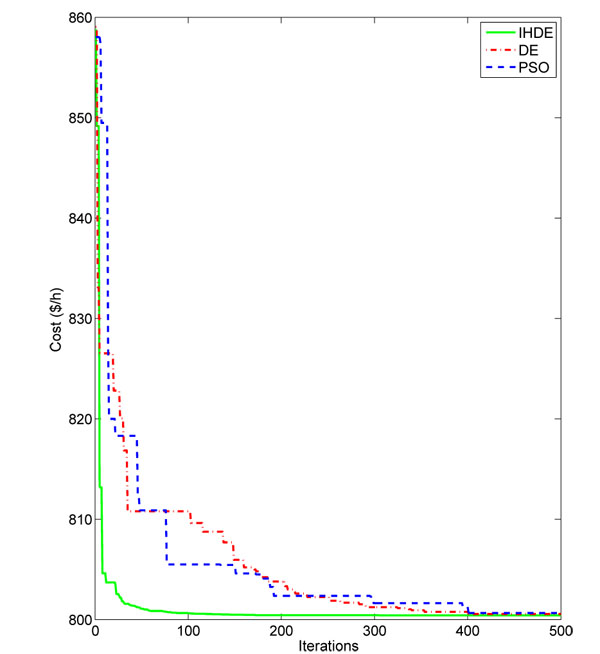 ) shows the optimal convergence curves and Fig. (2
) shows the optimal convergence curves and Fig. (2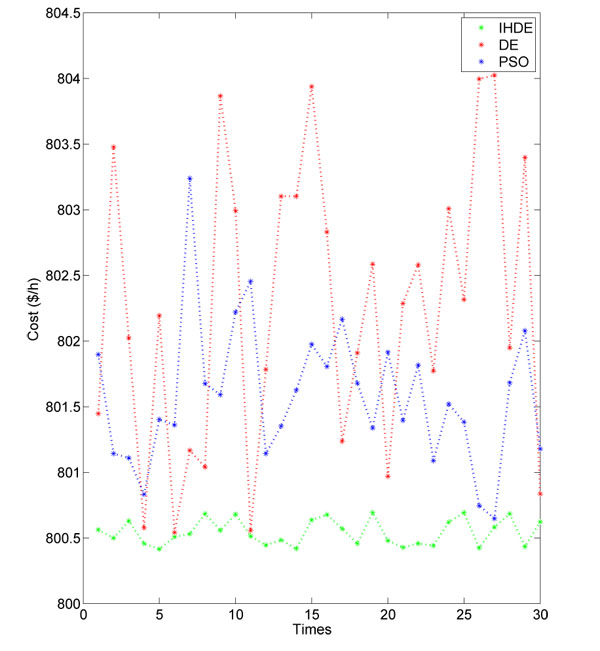 ) shows the results in 30 independent simulations of IHDE, DE, and PSO for case 1. It can be seen in Fig. (2
) shows the results in 30 independent simulations of IHDE, DE, and PSO for case 1. It can be seen in Fig. (2 ) that IHDE has a stronger robustness.
) that IHDE has a stronger robustness.
5.1.2. Case 2: Minimization of Transmission Real Power Losses
The objective function of minimization of transmission real power losses is defined as Eq.(15). The optimal control variables of IHDE, DE, and PSO for case 2 also are shown in Table 3 and the comparison of the results obtained from other methods reported in the literatures are shown in Table 5. As shown in the tables, the minimization of transmission real power losses obtained by IHDE, DE, and PSO are 3.085644 MW, 3.128384 MW and 800.3.132461 MW, respectively. And the result of IHDE is better than DE, PSO, ABC [7M.R. Adaryani, and A. Karami, "Artificial bee colony algorithm for solving multi-objective optimal power flow problem", Elect. Power Energy Sys., vol. 53, pp. 219-230.
[http://dx.doi.org/10.1016/j.ijepes.2013.04.021] ], DSA [12K. Abaci, and V. Yamacli, "Differential search algorithm for solving multi-objective optimal power flow problem", Elect. Power Energy Sys., vol. 79, pp. 1-10.
[http://dx.doi.org/10.1016/j.ijepes.2015.12.021] ], MSA [11A.A. Mohamed, Y.S. Mohamed, and A.A. El-Gaafary, "Optimal power flow using moth swarm algorithm", Electr. Power Syst. Res., vol. 142, pp. 190-206.
[http://dx.doi.org/10.1016/j.epsr.2016.09.025] ] and MGBICA [22M. Ghasemi, S. Ghavidel, M.M. Ghanbarian, and M. Gitizadeh, "Multi-objective optimal electric power planning in the power system using Gaussian bare-bones imperialist competitive algorithm", Inf. Sci., vol. 294, pp. 286-304.
[http://dx.doi.org/10.1016/j.ins.2014.09.051] ]. On the other hand, the result of HS [25S. S, and S. K.S, "Multi-objective harmony search algorithm for optimal power flow problem", Int J Elec Power, vol. 33, pp. 745-752.
[http://dx.doi.org/10.1016/j.ijepes.2010.12.031] ] is less than IHDE’s and defined as infeasible solution because it doesn’t satisfy the security constraints. Furthermore, Fig. (3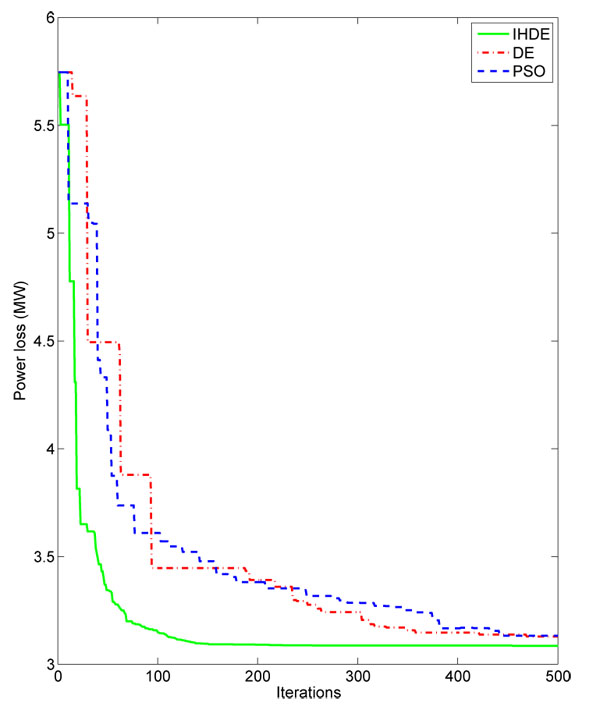 ) shows the optimal convergence curves and Fig. (4
) shows the optimal convergence curves and Fig. (4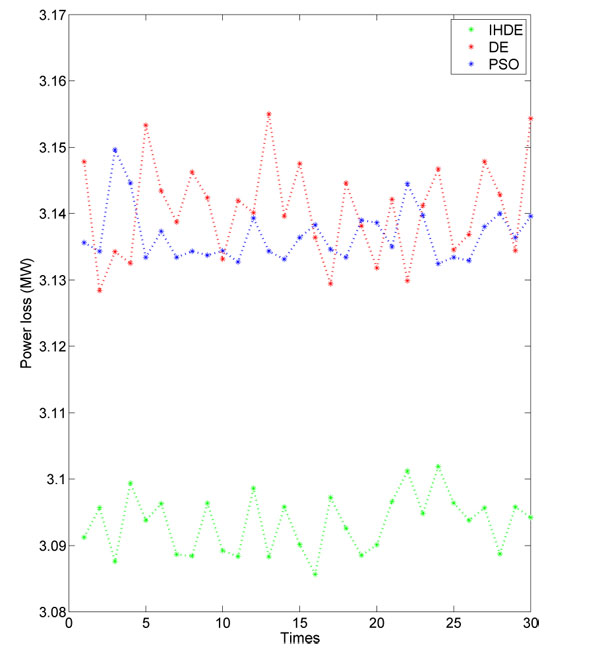 ) shows the results in 30 independent simulations of IHDE, DE, and PSO for case 2. Fig. (3
) shows the results in 30 independent simulations of IHDE, DE, and PSO for case 2. Fig. (3 ) demonstrates that IHDE has better convergence.
) demonstrates that IHDE has better convergence.
 |
Fig. (1) The optimal convergence curves for Case 1 of IEEE 30-bus system. |
 |
Fig. (2) The results' distribution for Case1 of IEEE 30-bus system. |
 |
Fig. (3) The optimal convergence curves for Case 2 of IEEE 30-bus system. |
5.2. IEEE 57-Bus System
The system has 7 generators, 3 shunt VAR compensations and 15 transformers, which also has 12.508 p.u. for the active power demand and 3.364 p.u. for the reactive power demand on base of 100MVA. All detailed line date, the bus date and the cost coefficients are given in [26R.D. Zimmerman, C.E. Murillo-Sánchez, and R.J. Thomas, Matpower, Available: http://www.pserc.cornell.edu/matpower]. The minimum and maximum limits of transformer taps are 0.9p.u. and 1.1p.u., respectively. The lower and upper limits of bus shunt capacitors are 0.0p.u. and 0.3p.u., respectively. Furthermore, the voltage magnitudes of generator buses are assumed to vary in the range [0.9, 1.1] p.u. and the lower and upper limits of load buses are considered to be 0.94p.u. and 1.06p.u., respectively. In this system, the maximum iteration number gmax is set as 1000.
 |
Fig. (4) The results' distribution for Case2 of IEEE 30-bus system. |
5.2.1. Case 3: Minimization of Quadratic Cost Function
The objective function is defined as case 1. The optimal control variables of IHDE, DE, and PSO for case 3 are shown in Table 6 and the comparison of the results obtained from other methods reported in the literatures are shown in Table 7. As shown in the tables, the minimization of quadratic cost obtained by IHDE, DE, and PSO for case 3 are 41667.99 $/h, 41699.16 $/h and 41702.78 $/h, respectively, and the result of IHDE is better than DE, PSO, ABC [7M.R. Adaryani, and A. Karami, "Artificial bee colony algorithm for solving multi-objective optimal power flow problem", Elect. Power Energy Sys., vol. 53, pp. 219-230.
[http://dx.doi.org/10.1016/j.ijepes.2013.04.021] ], ICBO [1H.R. Bouchekara, A.E. Chaib, M.A. Abido, and R.A. El-Sehiemy, "Optimal power flow using an Improved Colliding Bodies Optimizationalgorithm", Appl. Soft Comput., vol. 42, pp. 119-131.
[http://dx.doi.org/10.1016/j.asoc.2016.01.041] ], DSA [12K. Abaci, and V. Yamacli, "Differential search algorithm for solving multi-objective optimal power flow problem", Elect. Power Energy Sys., vol. 79, pp. 1-10.
[http://dx.doi.org/10.1016/j.ijepes.2015.12.021] ] and MSA [11A.A. Mohamed, Y.S. Mohamed, and A.A. El-Gaafary, "Optimal power flow using moth swarm algorithm", Electr. Power Syst. Res., vol. 142, pp. 190-206.
[http://dx.doi.org/10.1016/j.epsr.2016.09.025] ]. The Table 6 demonstrates IHDE algorithm can get less cost than other intelligent algorithms in the feasible space. Moreover, Fig. (5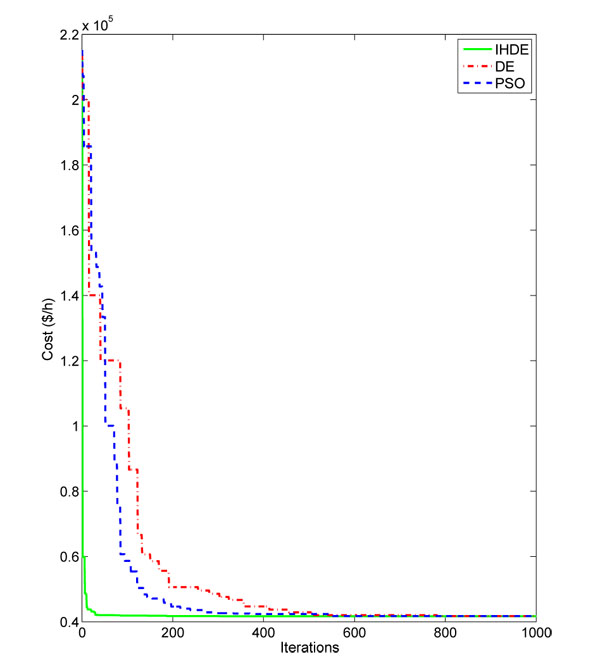 ) shows the optimal convergence curves and Fig. (6
) shows the optimal convergence curves and Fig. (6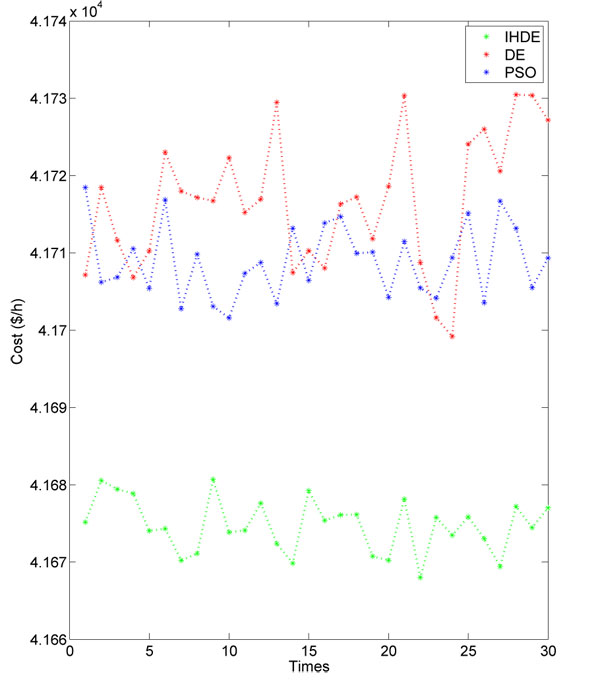 ) shows the results in 30 independent simulations of IHDE, DE, and PSO for case 3.
) shows the results in 30 independent simulations of IHDE, DE, and PSO for case 3.
 |
Fig. (5) The optimal convergence curves for Case 3 of IEEE 57-bus system. |
 |
Fig. (6) The results' distribution for Case3 of IEEE 57-bus system. |
CONCLUSION
An improved hybrid differential evolution algorithm (IHDE) based on DE and PSO has been proposed in this paper to solve the optimal power flow problem which is a large-scale, multi-constrained and nonlinear optimization problem. In order to show the practicability of the proposed algorithm, the generator quadratic cost and the transmission real power losses objective functions are considered for the OPF problem. Then the IHDE, DE and PSO are tested on the two systems: IEEE30-bus system and IEEE57-bus system. Furthermore, the results obtained from the IHDE algorithm are compared with DE, PSO and other methods reported in the recent literatures. As the simulation results indicated, the IHDE algorithm can solve the OPF problem successfully and has better robustness and convergence characteristics while getting the solutions with high quality.
CONSENT FOR PUBLICATION
Not applicable.
CONFLICT OF INTEREST
The authors declare no conflict of interest, financial or otherwise.
ACKNOWLEDGEMENTS
The authors would like to thank the editors and the reviewers for their constructive comments. This work was supported by the National Natural Science Foundation of China (Nos. 51507024 and 61263030) and Science and Technology Research Project of Chongqing Municipal Education Commission (No. KJ1500401).
REFERENCES
| [1] | H.R. Bouchekara, A.E. Chaib, M.A. Abido, and R.A. El-Sehiemy, "Optimal power flow using an Improved Colliding Bodies Optimizationalgorithm", Appl. Soft Comput., vol. 42, pp. 119-131. [http://dx.doi.org/10.1016/j.asoc.2016.01.041] |
| [2] | S.S. Reddy, and P.R. Bijwe, "Efficiency improvements in meta-heuristic algorithms to solve the optimal power flow problem", Elect. Power Energy Sys., vol. 82, pp. 288-302. [http://dx.doi.org/10.1016/j.ijepes.2016.03.028] |
| [3] | B. Mota-Palomino, and V.H. Quintana, "Sparse Reactive Power Scheduling by a Penalty Function - Linear Programming Technique", Ieee T Power Syst, vol. 1, pp. 31-39. [http://dx.doi.org/10.1109/TPWRS.1986.4334951] |
| [4] | R. Shoults, and D. Sun, "Optimal Power Flow Based Upon P-Q Decomposition", IEEE Trans. Power Apparatus Syst, vol. PAS-101, pp. 397-405. [http://dx.doi.org/10.1109/TPAS.1982.317120] |
| [5] | J. Carpentier, "Contribution a l’Etude du Dispatching Economique", Bulletin de la Societe Francaise des Electriciens, vol. 3, pp. 431-474. |
| [6] | R.P. Singh, V. Mukherjee, and S.P. Ghoshal, "Particle swarm optimization with an aging leader and challengers algorithm for the solution of optimal power flow problem", Appl. Soft Comput., vol. 40, pp. 161-177. [http://dx.doi.org/10.1016/j.asoc.2015.11.027] |
| [7] | M.R. Adaryani, and A. Karami, "Artificial bee colony algorithm for solving multi-objective optimal power flow problem", Elect. Power Energy Sys., vol. 53, pp. 219-230. [http://dx.doi.org/10.1016/j.ijepes.2013.04.021] |
| [8] | M. Ghasemi, S. Ghavidel, M. Gitizadeh, and E. Akbari, "An improved teaching–learning-based optimization algorithm using Lévy mutation strategy for non-smooth optimal power flow", Elect. Power Energy Sys., vol. 65, pp. 375-384. [http://dx.doi.org/10.1016/j.ijepes.2014.10.027] |
| [9] | P. Roy, and C. Paul, "Optimal power flow using krill herd algorithm", Inte. Transac. Elect. Energy Sys., vol. 25, pp. 1397-1419. [http://dx.doi.org/10.1002/etep.1888] |
| [10] | A.R. Kumar, and L. Premalatha, "Optimal power flow for a deregulated power system using adaptive real coded biogeography-based optimization", Elect. Power Energy Sys., vol. 73, pp. 393-399. [http://dx.doi.org/10.1016/j.ijepes.2015.05.011] |
| [11] | A.A. Mohamed, Y.S. Mohamed, and A.A. El-Gaafary, "Optimal power flow using moth swarm algorithm", Electr. Power Syst. Res., vol. 142, pp. 190-206. [http://dx.doi.org/10.1016/j.epsr.2016.09.025] |
| [12] | K. Abaci, and V. Yamacli, "Differential search algorithm for solving multi-objective optimal power flow problem", Elect. Power Energy Sys., vol. 79, pp. 1-10. [http://dx.doi.org/10.1016/j.ijepes.2015.12.021] |
| [13] | M. Basu, "Improved differential evolution for economic dispatch", Elect. Power Energy Sys., vol. 63, pp. 855-861. [http://dx.doi.org/10.1016/j.ijepes.2014.07.003] |
| [14] | R.P. Parouha, and K.N. Das, "A memory based differential evolution algorithm for unconstrained optimization", Appl. Soft Comput., vol. 38, pp. 501-517. [http://dx.doi.org/10.1016/j.asoc.2015.10.022] |
| [15] | G. Chen, S. Huang, and Z. Sun, "A Chaotic Quantum Behaved Particle Swarm Optimization Algorithm for Short-term Hydrothermal Scheduling", Open Elect. Electro. Engi. J., vol. 11, pp. 23-37. [http://dx.doi.org/10.2174/1874129001711010023] |
| [16] | S. Xie, R. Zhai, X. Liu, B. Li, K. Long, and Q. Ai, "Self-adaptive Genetic Algorithm and Fuzzy Decision Based Multiobjective Optimization in Microgrid with DGs", Open Elect. Electro. Engi. J., vol. 10, pp. 46-57. [http://dx.doi.org/10.2174/1874129001610010046] |
| [17] | X. Wang, C. Wang, and Q. Li, "Short-term Wind Power Prediction Using GA-ELM", Open Elect. Electro. Engi. J., vol. 11, pp. 48-56. [http://dx.doi.org/10.2174/1874129001711010048] |
| [18] | G. Chen, L. Liu, Z. Zhang, and S. Huang, "Optimal reactive power dispatch by improved GSA-based algorithm with the novel strategies to handle constraints", Appl. Soft Comput., vol. 50, pp. 58-70. [http://dx.doi.org/10.1016/j.asoc.2016.11.008] |
| [19] | G. Li, Q. Lin, L. Cui, Z. Du, Z. Liang, and J. Chen, "A novel hybrid differential evolution algorithm with modified CoDE and JADE", Appl. Soft Comput., vol. 47, pp. 577-599. [http://dx.doi.org/10.1016/j.asoc.2016.06.011] |
| [20] | Z. Zhao, J. Yang, Z. Hu, and H. Che, "A differential evolution algorithm with self-adaptive strategy and control parameters based on symmetric Latin hypercube design for unconstrained optimization problems", Eur. J. Oper. Res., vol. 250, pp. 30-45. [http://dx.doi.org/10.1016/j.ejor.2015.10.043] |
| [21] | O. Alsac, and B. Stott, "Optimal Load Flow with Steady-State Security", IEEE Trans. Power Apparatus Syst, vol. 93, pp. 745-751. [http://dx.doi.org/10.1109/TPAS.1974.293972] |
| [22] | M. Ghasemi, S. Ghavidel, M.M. Ghanbarian, and M. Gitizadeh, "Multi-objective optimal electric power planning in the power system using Gaussian bare-bones imperialist competitive algorithm", Inf. Sci., vol. 294, pp. 286-304. [http://dx.doi.org/10.1016/j.ins.2014.09.051] |
| [23] | S. Duman, U.U. Güvenç, Y. Sönmez, and N. Yörükeren, "Optimal power flow using gravitational search algorithm", Energy Convers. Manage., vol. 59, pp. 86-95. [http://dx.doi.org/10.1016/j.enconman.2012.02.024] |
| [24] | A. Bhattacharya, and P.K. Chattopadhyay, "Application of biogeography-based optimisation to solve different optimal power flow problems", IET Gener. Transm. Distrib., vol. 5, pp. 70-80. [http://dx.doi.org/10.1049/iet-gtd.2010.0237] |
| [25] | S. S, and S. K.S, "Multi-objective harmony search algorithm for optimal power flow problem", Int J Elec Power, vol. 33, pp. 745-752. [http://dx.doi.org/10.1016/j.ijepes.2010.12.031] |
| [26] | R.D. Zimmerman, C.E. Murillo-Sánchez, and R.J. Thomas, Matpower, Available: http://www.pserc.cornell.edu/matpower |




